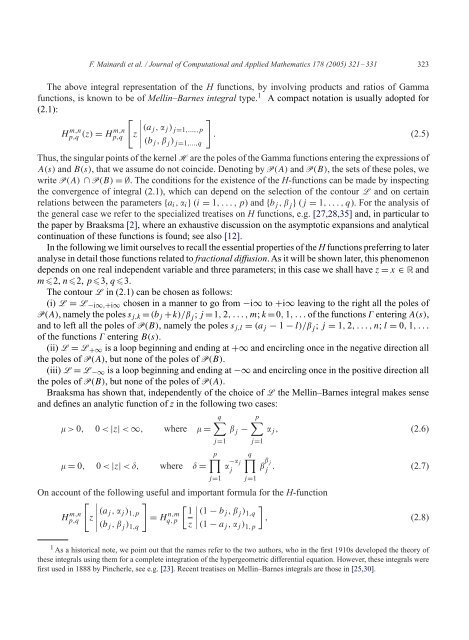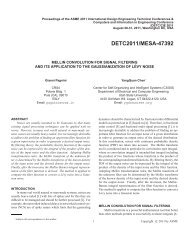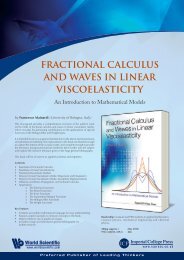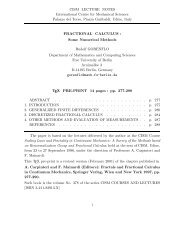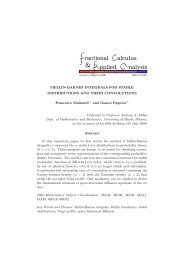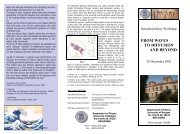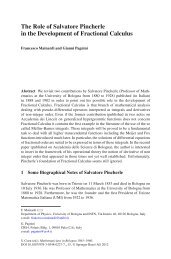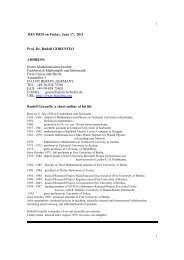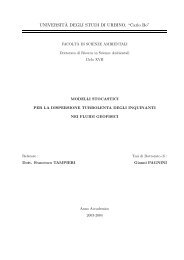Fox H functions in fractional diffusion - FRActional CALculus ...
Fox H functions in fractional diffusion - FRActional CALculus ...
Fox H functions in fractional diffusion - FRActional CALculus ...
You also want an ePaper? Increase the reach of your titles
YUMPU automatically turns print PDFs into web optimized ePapers that Google loves.
F. Ma<strong>in</strong>ardi et al. / Journal of Computational and Applied Mathematics 178 (2005) 321–331 323<br />
The above <strong>in</strong>tegral representation of the H <strong>functions</strong>, by <strong>in</strong>volv<strong>in</strong>g products and ratios of Gamma<br />
<strong>functions</strong>, is known to be of Mell<strong>in</strong>–Barnes <strong>in</strong>tegral type. 1 A compact notation is usually adopted for<br />
(2.1):<br />
H m,n<br />
<br />
<br />
<br />
m,n (aj<br />
, j ) j=1,...,,p<br />
p,q (z) = Hp,q z <br />
.<br />
<br />
(2.5)<br />
(bj , j ) j=1,...,q<br />
Thus, the s<strong>in</strong>gular po<strong>in</strong>ts of the kernel H are the poles of the Gamma <strong>functions</strong> enter<strong>in</strong>g the expressions of<br />
A(s) and B(s), that we assume do not co<strong>in</strong>cide.Denot<strong>in</strong>g by P(A) and P(B), the sets of these poles, we<br />
write P(A) ∩ P(B) =∅. The conditions for the existence of the H-<strong>functions</strong> can be made by <strong>in</strong>spect<strong>in</strong>g<br />
the convergence of <strong>in</strong>tegral (2.1), which can depend on the selection of the contour L and on certa<strong>in</strong><br />
relations between the parameters {ai, i} (i = 1,...,p) and {bj , j } (j = 1,...,q).For the analysis of<br />
the general case we refer to the specialized treatises on H <strong>functions</strong>, e.g. [27,28,35] and, <strong>in</strong> particular to<br />
the paper by Braaksma [2], where an exhaustive discussion on the asymptotic expansions and analytical<br />
cont<strong>in</strong>uation of these <strong>functions</strong> is found; see also [12].<br />
In the follow<strong>in</strong>g we limit ourselves to recall the essential properties of the H <strong>functions</strong> preferr<strong>in</strong>g to later<br />
analyse <strong>in</strong> detail those <strong>functions</strong> related to <strong>fractional</strong> <strong>diffusion</strong>.As it will be shown later, this phenomenon<br />
depends on one real <strong>in</strong>dependent variable and three parameters; <strong>in</strong> this case we shall have z = x ∈ R and<br />
m2, n2, p 3, q 3.<br />
The contour L <strong>in</strong> (2.1) can be chosen as follows:<br />
(i) L = L−i∞,+i∞ chosen <strong>in</strong> a manner to go from −i∞ to +i∞ leav<strong>in</strong>g to the right all the poles of<br />
P(A), namely the poles sj,k =(bj +k)/j ; j =1, 2,...,m; k =0, 1,...of the <strong>functions</strong> enter<strong>in</strong>g A(s),<br />
and to left all the poles of P(B), namely the poles sj,l = (aj − 1 − l)/j ; j = 1, 2,...,n; l = 0, 1,...<br />
of the <strong>functions</strong> enter<strong>in</strong>g B(s).<br />
(ii) L = L+∞ is a loop beg<strong>in</strong>n<strong>in</strong>g and end<strong>in</strong>g at +∞ and encircl<strong>in</strong>g once <strong>in</strong> the negative direction all<br />
the poles of P(A), but none of the poles of P(B).<br />
(iii) L = L−∞ is a loop beg<strong>in</strong>n<strong>in</strong>g and end<strong>in</strong>g at −∞ and encircl<strong>in</strong>g once <strong>in</strong> the positive direction all<br />
the poles of P(B), but none of the poles of P(A).<br />
Braaksma has shown that, <strong>in</strong>dependently of the choice of L the Mell<strong>in</strong>–Barnes <strong>in</strong>tegral makes sense<br />
and def<strong>in</strong>es an analytic function of z <strong>in</strong> the follow<strong>in</strong>g two cases:<br />
q p<br />
> 0, 0 < |z| < ∞, where = j − j , (2.6)<br />
= 0, 0 < |z| < , where =<br />
(bj , j ) 1,q<br />
j=1<br />
p<br />
j=1<br />
−j<br />
j<br />
j=1<br />
q<br />
j=1<br />
j j . (2.7)<br />
On account of the follow<strong>in</strong>g useful and important formula for the H-function<br />
H m,n<br />
<br />
<br />
(aj<br />
, j ) 1,p<br />
p,q z <br />
= H<br />
<br />
n,m<br />
<br />
<br />
1 <br />
<br />
(1 − bj , j ) 1,q<br />
q,p<br />
z <br />
, (2.8)<br />
(1 − aj , j ) 1,p<br />
1 As a historical note, we po<strong>in</strong>t out that the names refer to the two authors, who <strong>in</strong> the first 1910s developed the theory of<br />
these <strong>in</strong>tegrals us<strong>in</strong>g them for a complete <strong>in</strong>tegration of the hypergeometric differential equation.However, these <strong>in</strong>tegrals were<br />
first used <strong>in</strong> 1888 by P<strong>in</strong>cherle, see e.g. [23].Recent treatises on Mell<strong>in</strong>–Barnes <strong>in</strong>tegrals are those <strong>in</strong> [25,30].


